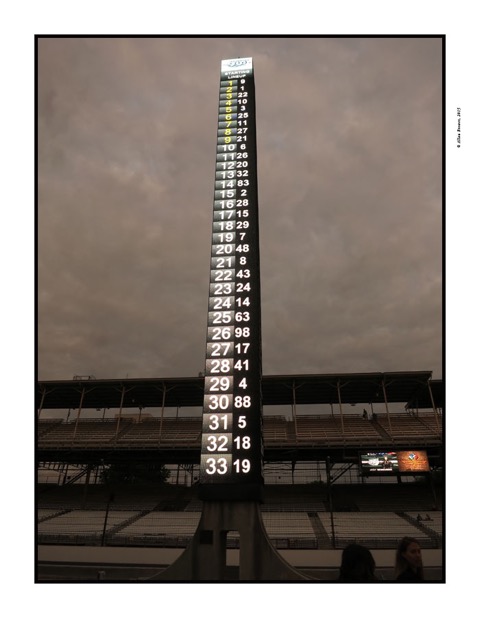Indy’s New Pylon Perched For A Performance Of Its Own
- Updated: May 24, 2015
 Allan Brewer Photo
Allan Brewer Photo
Indianapolis—What never moves but will be the focus of all eyes throughout the day at the Indianapolis 500?
It’s the pencil-thin, four-sided black scoring pylon that watches the Indianapolis 500 from its perch at the exit of Gasoline Alley onto the famous Indianapolis Motor Speedway oval.
 This year the scoring pylon has a new look and some new moves to show the fans as they enter and watch the 99th running of the Greatest Spectacle in Racing.
This year the scoring pylon has a new look and some new moves to show the fans as they enter and watch the 99th running of the Greatest Spectacle in Racing.
When the green flag drops today the pylon will go green as well, with a 92-foot tall green, four-sided guide to what’s happening on the track. And when the yellow inevitably comes out, be it for a racing incident or the fickle May weather in Indy, the pylon will turn yellow as well. The same applies if we suffer a race stoppage with a red warning that the cars must pit.
There’s another treat in store during the national anthem on race day: the pylon is capable of sophisticated digital graphics and will unfurl a beautiful red, white and blue American flag fluttering as if at rest on a flagpole.
The pylon can now handle animation as well.
This is the third scoring device that the Speedway has operated on race day. The first, constructed in 1929 was a purely manual device on which laps, position and average speed were recorded.
Like the original Pagoda, or control tower, at IMS the original scoreboard came down and was replaced in 1994 with a mechanical device that graced the Brickyard for 20 years. This iteration of the pylon scored position and lap count of the race.
It in turn was replaced in July, 2014 by the newest electronic version. It was built by Panasonic to move forward into another century with the Indianapolis 500 lit-erally at its side.
“We wanted to generate more information, to give more information to the fans in their seats,” said Indianapolis Motor Speedway President J. Douglas Boles of the new technological wonder.
“That old pylon was iconic, so we wanted to make sure the size of the new one was similar—we’re about two feet taller and three inches wider—but we wanted the ability to light it up, especially for the Indianapolis 500.”
In its base Indy 500 mode the new pylon looks identical to the one it replaced, with the race cars ordered 1-33 on its sides and the lap count at the top beneath a swinging orange wind-sock.
The new pylon showed off its great additional capabilities during qualifying and the weeks leading up to the race: it lit up with “Indianapolis Motor Speedway,” race logos, with commercial messages for beer and gasoline and the online service provider Angie’s List.
“I think the fans, even fans that are a little concerned about it, are going to find that we’ve done a great job of paying real close attention to our tradition but also giving them something that makes their experience here at the Speedway better,” said Boles of the changes.
The new pylon boasts cross-functional capability with room for the top ten cars on the track during the NASCAR Brickyard 400 before it cycles to a full-length display of spots 11-43 positions during the race.
Technologically the scoring pylon on display today is a sensational compilation of 1320 LED panels mounted up and down the structure on four sides, for a total of 5280 HDTV’s stacked high above the race track.
The previous pylon was no slouch in this regard, powered by 6,496 30-watt light bulbs, but could only display basic race scoring with a space at the top for race logos.
The pylon joins new Panasonic video boards on a long list of major capital im-provements planned by IMS prior to the 100th Running of the Indianapolis 500 in 2016.
The “Project 100” initiative includes renovations across all aspects of facility op-erations, from seating, connectivity and technology to fan experiences and track improvements.
Allan Brewer covers IndyCar and other racing series for RacingNation.com. Allan is a fixture at the race track, armed with keyboard and camera, eager to take you inside open-wheel sport where the news is being made. He comes to RacingNation.com with multiple professional awards from the American Auto Racing Writers and Broadcasters Association (AWWRBA). He began his motorsports writing career at FastMachines.com; and solely published IndyProRacer.com and A1GP.com, two award-winning websites for open-wheel racing’s junior leagues, prior to becoming IndyCar correspondent at Motorsport.com. He has also covered Formula 1, NASCAR, Formula E, the Indy Lights Series and its predecessor Indy Pro Series, NHRA events and major auto shows. His major interest outside of competition is automotive technology and its application to the cars we drive every day on the public highways.





![Race winning WTR Andretti Acura. [Photo by Jack Webster]](https://racingnation.com/wp-content/uploads/2024/04/Acura_comp-300x195.jpg)
![[Jack Webster Photo]](https://racingnation.com/wp-content/uploads/2024/03/Ferrari3_compressed-300x195.jpg)
![[Abed Ismail Photo]](https://racingnation.com/wp-content/uploads/2024/03/AD-abed-ismail_compressed-300x195.jpg)

![Porsche Fabcar crosses the finish line. [Robert Madara photo]](https://racingnation.com/wp-content/uploads/2023/11/FabcarFinish-108x70.jpeg)

![USF2000 Pro driver Lindsay Brewer. [Eddie LePine Photo]](https://racingnation.com/wp-content/uploads/2023/06/IMG_8825_2-108x70.jpg)